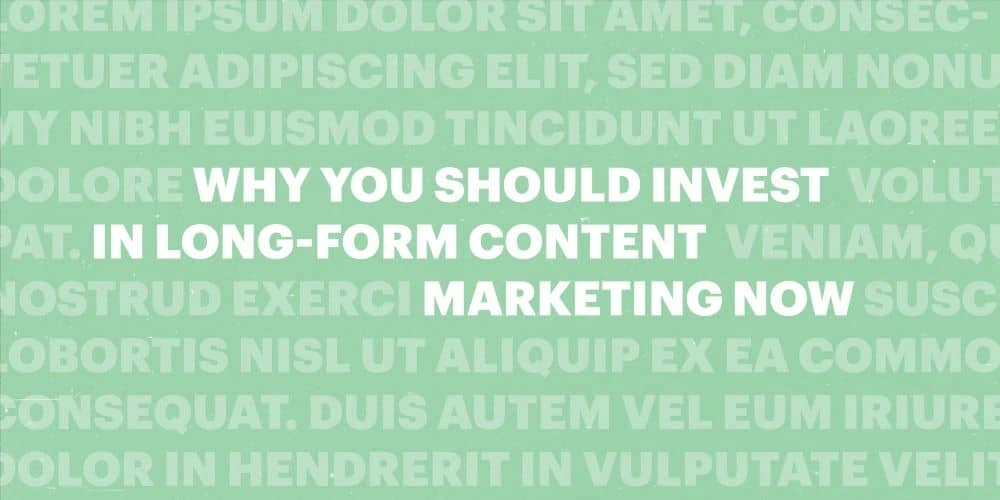Perhaps the term “long-form content” has made its way into the Promotions tab of your inbox a few times recently. Typical best practices for creating digital content suggest short-form content frequently seen in social content and webpages are easier to digest. However, there is a growing demand for long-form content in digital marketing.
What is long-form content?
Basically, long-form content is content with a word count of 1,200 words or more (according to Forbes). It can be a traditional blog post as well as a magazine, an eBook or a white paper, and a lot of voices are saying it’s the next big thing.
Do you have a negative knee-jerk reaction when you see someone touting long-form content’s wonders? Maybe what comes to mind is 7,000 words of text forming an intimidating mass that could cause minor head trauma if picked up and swung. Or possibly horrible flashbacks to school textbooks.
Let me start by saying that I am a millennial through and through, so thinking about a lot of boring text doesn’t really get me going. However, I am a believer in using long-form content in your content strategy.
Why?
Because if content (of any kind) is good enough, then people will stay on board for the long haul. [![]() ]
]
This means they’ll spend more time with your brand and come to rely on you for dependable information and thought leadership.
Sure, our attention spans are getting shorter, but I like to think that, in many cases, what that really means is that we’re getting better at quickly determining what we want to spend time on and what we don’t care about. To survive a digital world filled to the brim with content, we have to pass on a lot of things, and do it quickly.
But think, for example, of the enormous success of The Lord of the Rings film trilogy. Though each of the films had a runtime of about 3 hours, the trilogy became a sensation and earned a whopping $2.9 billion worldwide. Why were people willing to follow 9 hours of film? Because there was a good story to tell. It was engaging and entertaining, and it was important to people.

To really drive this point home, think about all the people that weren’t satisfied with just 9 hours of LOTR and bought the extended editions so they could get even more of what they loved. If you’re on an exciting roller coaster, you’re not waiting for it to end—you want more!
So how can your content marketing capture people’s attention like The Lord of the Rings? It boils down to two things: looking good and being interesting. The trilogy was visually stunning, and it had a captivating story. With hard work, your content can achieve the same results.
If you find an engaging story to tell and give some thought to the design of your content, you can create something that will add value to your readers and keep them coming back for more. The film example demonstrates that length and storytelling easily coexist when the story’s right—but what about good design?
How can long-form content look good?
To speak to aesthetically motivated fears, I actually think that good long-form content can sometimes be more visually appealing and less intimidating than its alternative. Take for example, these two versions of the CRM tool Highrise’s website.
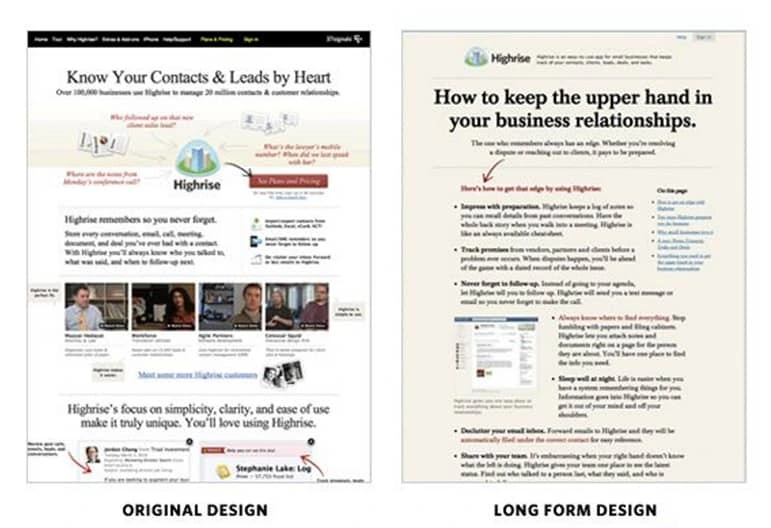
My first impression is that the original design is overwhelming and all over the place. It stresses me out trying to decide where to begin. The long-form design, on the other hand, is inviting and easy to follow. It’s designed in a way that is engaging, even while being longer. And here’s the kicker: Highrise’s long-form redesign increased conversions by 37.5%.
One reason that people may be more comfortable with a long-form design like Highrise’s is that it jives with what we’ve become accustomed to over hundreds of years. We’ve been reading books for a long time, so the layout of a long-form piece of content recalls familiar memories of your favorite novel. This effect is the result of careful design, and that’s where I feel Lucidpress can make a big difference. But more on that later.
What are some other benefits of long-form content?
In 2012, serpIQ conducted a study of more than 20,000 keywords and found that the top 10 search engine results had an average content length of more than 2,000 words, with the average number of words in the #1 spot at 2,416. Since long-form pages rank better in search engines on average, it’s likely more people will find your page and become customers. A few words from Google hint at the SEO possibilities of long-form content marketing:
“Users often turn to Google to answer a quick question, but research suggests that up to 10% of users’ daily information needs involve learning about a broad topic. That’s why today we’re introducing new search results to help users find in-depth articles.”
Pandu Nayak, creator of the Panda algorithm update
Another long-form content success story is Crazy Egg. They increased conversion rates by more than 30% with the use of long-form content. Also, this long-form content was approximately 20x longer than the previous version. That’s pretty dramatic, but so is a 30% increase in conversions. Here’s what Conversion Rate Experts had to say on the matter:
“The media would have us believe that people no longer have any capacity to concentrate. In reality, you cannot have a page that’s too long—only one that’s too boring. In the case of Crazy Egg’s homepage, visitors wanted their many questions answered and that’s what we delivered.”
I completely agree.
How to get started creating long-form content:
1. Determine your area of expertise. This will help you know what topic to write about. For me, I work in content marketing, so I feel like I have something to offer there. For you, it may be design, SEO, entrepreneurship, or, I don’t know, beekeeping. You’ll be able to tell the best story if you’re talking about something you’re closely involved with.
2. Research. For this post, I started out by googling “innovative long-form content.” Build on your expertise by looking deeply into current trends, statistics, and conversations.
3. Identify your target audience. All content needs to be relevant to your audience, but it’s especially important for keeping your reader’s attention with long-form content
4. Decide on your medium. It may be a blog post, but it also might be a magazine, an eBook or a white paper. Determine the type of content that will give your story the best presentation and resonate most with your audience. For example, this post could have worked with a white paper or eBook template, but it wouldn’t have been right for a magazine. A magazine might be better for a monthly newsletter with highlights across several different areas rather than a singular focus.
5. Start writing, then tell everyone you know about it once you’re done!
Standout examples of long-form content
Now that we’ve talked about the benefits of long-form content, let’s take a look at the innovators. There are some companies and organizations out there who are really nailing long-form content, and I’d like to go over 5 examples. Let’s dive in.
1. NewsCred
NewsCred has mastered the art of the seemingly impossible by making the white paper sexy. They understand visual storytelling, and they’ve invested a lot in the future of content marketing. Here’s a page from one of their white papers:
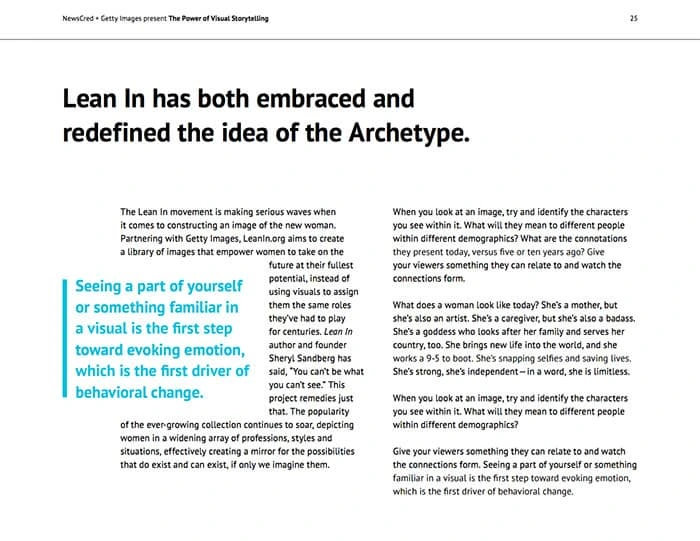
It’s manageable, it’s compelling, and it goes on for 35 pages. And you know what? I read through all of it. It captured my attention, and I walked away with valuable insights. NewsCred shows not just how long-form content can be compelling, but content in general. The long-form aspect of their content isn’t a gimmick—it’s just the best way to present the story they’re telling.
What NewsCred got right:
- Thought leadership (statistics, quotes, innovative ideas)
- Scannable and easily digestible
- Great design and striking images
2. Insider Journeys

Take a look at the beginning of this piece of content on Insider Journeys’ blog. Does it look like the start to an intimidating, boring content piece?
No. It’s immediately engaging and intriguing. Right when I opened it up, it had my attention, which it kept as I scrolled through page after page of what I think is best categorized as a mini-site.
I think this piece is the most elegant and beautiful long-form content I’ve come across in my research. It also defies expectations of what long-form content is. As you progress through the mini-site, there are intriguing facts, fun stories, and even a recipe for “the perfect Vietnamese coffee.”
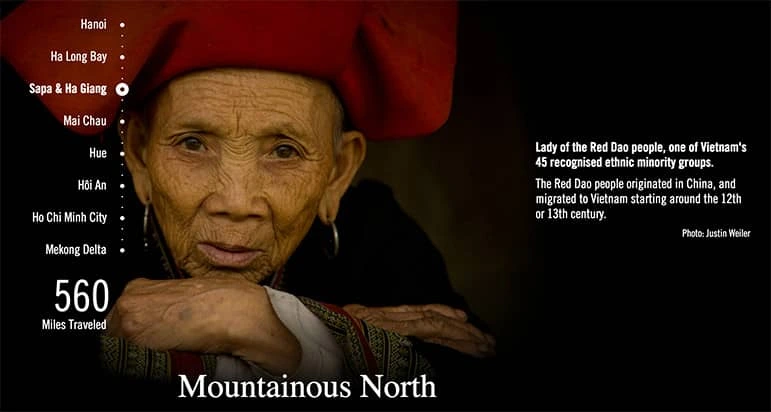
On Insider Journeys’ mini-site, we see a marriage of design, copywriting and storytelling presented in a refreshingly compelling way. They’ve set the bar for what businesses can strive for with their content, and I have a hunch that content like this will stand out as the web gets increasingly crowded.
What Insider Journeys got right:
- Great organization and natural progression keeps readers from getting lost while scanning
- Powerful storytelling
- Image-based presentation that holds readers’ attention
3. Towergate Insurance
Wait! Don’t click away because you saw “insurance” and nearly died from boredom. Yes, insurance isn’t the most entertaining subject you may come across, but Towergate has made a noteworthy accomplishment with long-form content by making insurance accessible.
The piece of content I’d like to specifically point out is a guide to commercial property insurance, which isn’t really my cup of tea. But I was impressed with how, after a quick scan, I was able to comprehend the main idea of a fairly dense topic.
Towergate’s clarity kept me from getting lost in volumes of unbroken text. This effect was enhanced by the clean layout of the content. Take a look:
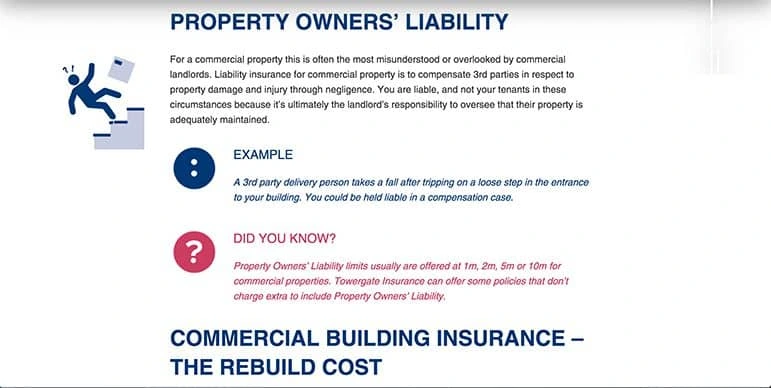
What Towergate got right:
- Straight to the point (still possible with long-form content)
- Clean layout
- Relevant section titles that aid in comprehension
I’d like to give credit to this great Moz article for helping me find this and the previous example.
4. Hip-Hop University

This example, along with the following one, are examples of long-form content that was made in Lucidpress. Before I go further, I want to be transparent about my motives here. First of all, I think these are great examples of well-designed, interesting long-form content made by smaller organizations. Beyond that, at Lucidpress, we really feel that businesses and organizations can benefit from using our product to revitalize their content marketing, especially in the long-form content space where design is crucial.
“Lucidpress template design makes everything very user friendly. I signed up to Lucidpress with no experience, but was able to achieve all of my needs and more.”
Albert Carter, co-founder of Hip-Hop University
Now back to Hip-Hop University’s digital magazine. There are two big reasons why I really like what they’re doing with this magazine. First of all, it’s a great example of long-form content presented in a unique way. Second, I appreciate Hip-Hop University’s commitment to furthering digital publishing and embracing its potential for content marketing.
Long-form content goes beyond the blog. You can have phenomenal long-form content in the form of digital magazines, eBooks, and as we saw earlier, white papers.
What Hip-Hop University got right:
- Innovative medium
- Professional cover that makes people want to read
- Blend of informative content and storytelling
5. International Academy of Wedding and Event Planning
This academy did a beautiful job with its 2016 Wedding Trend Report, and it’s all made in Lucidpress. This report is similar in form to an eBook, and it shows how diverse long-form content can be. The 2016 Wedding Trend Report combines illustration, photos and text to keep the content interesting, and it even utilizes Lucidpress’s interactive features with an embedded Youtube video.

What the International Academy got right:
- Interactive presentation
- Beautiful use of graphic elements
- Extensive thought leadership
Go forth and be awesome
I hope that something in this post has resonated with you and sparked some ideas about long-form content. It might be worth noting that this post is itself a piece of long-form content, and that’s because I really do think that long-form content will play an important role in content marketing’s future.
Go out and start experimenting with your content to find what fits best with your brand. You’ll need to determine what story you want to tell, and then tell it in a genuine, transparent way that lets your passion shine through. If it’s a good story, people will listen.
